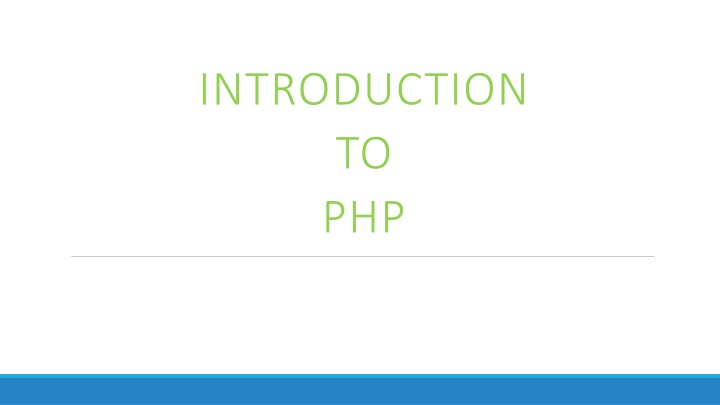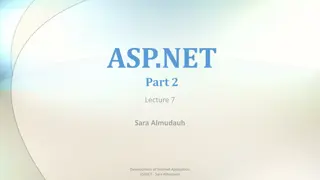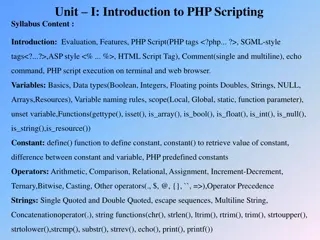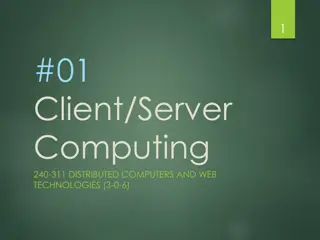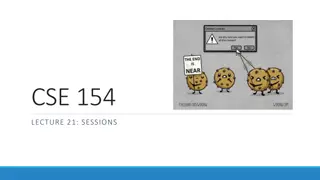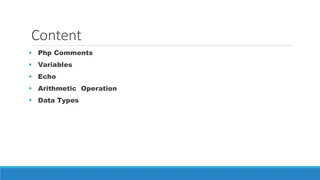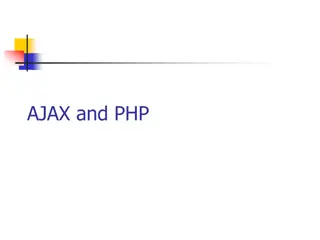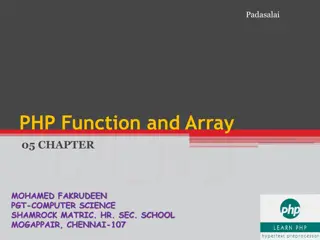Introduction to PHP - Server-Side Scripting Language Designed for the Web
PHP is a server-side scripting language specifically designed for the web. It allows embedding of PHP code within HTML pages to be executed on each visit, generating output interpreted at the server. Learn about URLs, web servers, server-side web programming, PHP history, its benefits, and why PHP is a popular choice for server-side languages.
Download Presentation

Please find below an Image/Link to download the presentation.
The content on the website is provided AS IS for your information and personal use only. It may not be sold, licensed, or shared on other websites without obtaining consent from the author.If you encounter any issues during the download, it is possible that the publisher has removed the file from their server.
You are allowed to download the files provided on this website for personal or commercial use, subject to the condition that they are used lawfully. All files are the property of their respective owners.
The content on the website is provided AS IS for your information and personal use only. It may not be sold, licensed, or shared on other websites without obtaining consent from the author.
E N D
Presentation Transcript
INTRODUCTION TO PHP
Introduction to PHP PHP is a server-side scripting language designed specifically for the Web. Within an HTML page, you can embed PHP code that will be executed each time the page is visited. Your PHP code is interpreted at the Web server and generates HTML or other output that the visitor will see ( PHP and MySQL Web Development , Luke Welling and Laura Thomson, SAMS)
URLs and web servers http://server/path/file usually when you type a URL in your browser: your computer looks up the server's IP address using DNS your browser connects to that IP address and requests the given file the web server software (e.g. Apache) grabs that file from the server's local file system, and sends back its contents to you some URLs actually specify programs that the web server should run, and then send their output back to you as the result: https://csjmu.ac.in/quote.php the above URL tells the server csjmu.ac.in to run the program quote.php and send back its output
Server-Side web programming server-side pages are programs written using one of many web programming languages/frameworks examples: PHP, Java/JSP, Ruby on Rails, ASP.NET, Python, Perl the web server contains software that allows it to run those programs and send back their output each language/framework has its pros and cons we will use PHP for server-side programming
PHP History 1994: Created by Rasmis Lesdorf, software engineer (part of Apache Team) 1995: Called Personal Home Page Tool, then released as version 2 with name PHP/FI (Form Interpreter, to analyze SQL queries) Half 1997: used by 50,000 web sites October 1998: used by 100,000 websites End 1999: used by 1,000,000 websites
Good about PHP Open-source Easy to use ( C-like and Perl-like syntax) Stable and fast Multiplatform Many databases support Many common built-in libraries Pre-installed in Linux distributions
Why PHP? There are many other options for server-side languages: Ruby on Rails, JSP, ASP.NET, etc. Why choose PHP? free and open source: anyone can run a PHP-enabled server free of charge compatible: supported by most popular web servers simple: lots of built-in functionality; familiar syntax available: installed on servers and most commercial web hosts well-documented: type php.net/functionName in browser Address bar to get docs for any function
What is PHP (contd) Interpreted language, scripts are parsed at run-time rather than compiled beforehand Executed on the server-side Source-code not visible by client View Source in browsers does not display the PHP code Various built-in functions allow for fast development Compatible with many popular databases
What does PHP code look like? Structurally similar to C/C++ Supports procedural and object-oriented paradigm (to some degree) All PHP statements end with a semi-colon Each PHP script must be enclosed in the reserved PHP tag <?php ?>
How PHP generates How PHP generates HTML/JS Web pages HTML/JS Web pages Client Browser 4 1 PHP module 3 Apache 2 1: Client from browser send HTTP request (with POST/GET variables) 2: Apache recognizes that a PHP script is requested and sends the request to PHP module 3: PHP interpreter executes PHP script, collects script output and sends it back 4: Apache replies to client using the PHP script output as HTML output
Lifecycle of a PHP web request browser requests a .html file (static content): server just sends that file browser requests a .php file (dynamic content): server reads it, runs any script code inside it, then
Console output: print print "text"; PHP print "Hello, World!\n"; print "Escape \"chars\" are the SAME as in Java!\n"; print "You can have line breaks in a string."; print 'A string can use "single-quotes". It\'s cool!'; PHP Hello, World! Escape "chars" are the SAME as in Java! You can have line breaks in a string. A string can use "single-quotes". It's cool! output some PHP programmers use the equivalent echo instead of print
